
No cenotaph after all!
The latest fieldwork campaign on the Late Pre-Roman/Early Roman Iron Age urn cemetery at Nienbüttel, which was successfully completed at the end of August, has yielded exciting results that provide an increasingly nuanced picture of the burial practices and concepts of the afterlife of Iron Age groups in the Barbaricum. In addition to three urn graves with ceramic cremation vessels, which represent the vast majority of all burials, a bronze urn from the Roman Empire was saved as block recovery. In contrast, a pit structure containing cremation remains and a large quantity of pottery that was flanked by weapon deposits has so far been without comparison. Of particular note was the large format stone concentration which had already been excavated in parts in March. Gustav Schwantes called such structure cenotaphs, i.e. empty or pseudo-graves, because he had found no or only few cremation remains inside. The category cenotaph now needs to be revised, as two bronze vessels, at least one of which was used as an urn, have been found in the recently excavated Nienbüttel stone accumulation that was also accompanied by weapon deposits. The vessels saved as block recoveries are currently analysed in detail as part of a summer school with students from the Stuttgart State Academy of Art and Design (ABK Stuttgart), which promises new insights into the social status of the deceased and the role of the enigmatic stone concentrations as an integral part of the cemetery.
